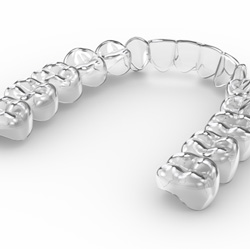Invisalign Grapevine
Clear Braces - Clearly Beautiful Results
 For teens and adults who would like to fix their crooked teeth without wearing metal braces for two or more years, there is an excellent orthodontic alternative with Invisalign in Grapevine, TX. This clear braces option has already helped over 4 million people worldwide enjoy healthier, more attractive smiles. Will you or your teen be the next to enjoy all the benefits of Invisalign?
For teens and adults who would like to fix their crooked teeth without wearing metal braces for two or more years, there is an excellent orthodontic alternative with Invisalign in Grapevine, TX. This clear braces option has already helped over 4 million people worldwide enjoy healthier, more attractive smiles. Will you or your teen be the next to enjoy all the benefits of Invisalign?
Why Choose Smiles by Martin for Invisalign?
- High-Quality Aligners for Teens and Adults
- Focus on Building Personal Relationships with Patients
- Team That Puts Your Comfort First
How Invisalign Works
 For teens and adults who would like to fix their crooked teeth without wearing metal braces for two or more years, there is an excellent orthodontic alternative with Invisalign in Grapevine, TX. This clear braces option has already helped over 4 million people worldwide enjoy healthier, more attractive smiles. Will you or your teen be the next to enjoy all the benefits of Invisalign?
For teens and adults who would like to fix their crooked teeth without wearing metal braces for two or more years, there is an excellent orthodontic alternative with Invisalign in Grapevine, TX. This clear braces option has already helped over 4 million people worldwide enjoy healthier, more attractive smiles. Will you or your teen be the next to enjoy all the benefits of Invisalign?
Invisalign straightens teeth using the same orthodontic principles as traditional braces, which means it gradually moves the teeth by placing focused pressure on different areas of the bite throughout treatment. But unlike metal braces, Invisalign works using a series of clear, plastic trays that you can remove to eat and clean.
The Invisalign aligners are created from digital scans taken of your teeth in the treatment planning phase. Once your aligners are ready, you will wear each one for two weeks before advancing to the next in the series. The trays are designed to fit your dentition as it gradually shifts throughout the treatment.
After you complete the Invisalign treatment, you will be fitted for a retainer. Most people need to wear it the majority of the day at first, and then only at night after a few months to keep their teeth in the proper position for a lifetime to come.
Invisalign Teen

Some dentists only offer Invisalign as an alternative solution to adults. The reason is that this type of treatment does require more responsibility on the part of the patient. However, older, more mature teenagers can also benefit from Invisalign. If your teenager is in need of orthodontic treatment and you think Invisalign could help them achieve a healthier smile, call us today to schedule a consultation to learn more about Invisalign Teen!
How is Invisalign Teen Different?

Invisalign Teen works much the same way as a normal Invisalign treatment. However, the aligners that your teenager receives will have a small dot on the back. This dot will change color over time based on how often your teen is wearing their aligners; this helps ensure that they are sticking to the treatment plan. Additionally, teenagers are generally given more replacement aligners than adults.
Is Invisalign Right for Your Teen?

Since Invisalign is more discreet than traditional braces, it can be a great option for teenagers who require orthodontic treatment and are self-conscious about their appearance. It should be noted that Invisalign tends to work best when it comes to making mild to moderate orthodontic corrections; more complex cases generally call for traditional braces.
The Benefits of Invisalign Teen

There are many reasons why Invisalign can be a great fit for the active lifestyle of your teenager. For one thing, there are no brackets or wires that could accidentally be damaged if the patient gets hit in the face while playing sports. Your teen will also likely find it easier to play an instrument without any braces to get in the way. Finally, since Invisalign is removable, your teenager will have the freedom to enjoy all of their favorite foods throughout the treatment.
Who Invisalign Can Help

Invisalign can be a good choice for making a variety of orthodontic corrections. Of course, our team will need to examine your smile to make sure that you’re a good fit for the procedure. In the meantime, though, here’s a brief look at some of the situations that Invisalign can help with.
Crowded Teeth
Teeth that are too closely crowded together can draw the wrong sort of attention, and you’re likely to find that it’s difficult to clean them as thoroughly as you need to. Invisalign can help straighten your teeth, gradually guiding them toward a better alignment.
Gaps Between Teeth
Sometimes your teeth may be spaced just a little too far apart; this can make it easier for food to get trapped in this area, thus increasing your risk for gum disease. Fortunately, Invisalign can often help correct this issue.
Bite Alignment
Overbite, underbite, crossbite, and open bite are all examples of bite problems that, if left alone, could ultimately have serious consequences for your teeth. Depending on the severity of your particular bite problem, Invisalign may be a viable solution.
The Benefits of Invisalign

Invisalign offers a number of benefits compared to traditional braces, especially for image-conscious teens and busy adults.
Some of the advantages of clear braces include the following:
- Your braces won't be the first thing people notice.
- You can take out Invisalign before important events, like meetings or presentations.
- Removable aligners also allow you to continue eating all your favorite foods without fear of breaking a bracket or popping off a wire.
- It can be tricky to brush and floss around traditional braces, but dental hygiene is as easy as ever with aligners you can take out to clean.
- Fewer visits to the dentist are required throughout treatment compared to traditional braces.
- Smooth plastic is often more comfortable than metal brackets and wires, which can create blisters in the soft oral tissues.
Understanding the Cost of Invisalign

How much will Invisalign cost in your case? The answer depends on the details of your unique treatment plan. Because the overall price can vary, the only way to get a firm idea of what the cost will look like is to schedule a consultation with our team so that we can examine your smile. Not only can we explain the factors that will influence the final price, but we can help you figure out the best way to make the treatment affordable.
Factors That Affect the Cost of Invisalign

The cost of Invisalign is dependent on a number of factors. Some of the variables that impact the cost of Invisalign include:
- Length of treatment – most patients complete Invisalign treatment in 12 months, but for others, the process can take up to 18 months. The longer treatment times will likely raise the cost of your Invisalign plan.
- The number of alignment trays – in addition to the overall length of treatment time, the number of aligners used to achieve the desired results will also impact the price. Patients need to wear the aligners for about two weeks on average, but these wear times vary, impacting the overall number of aligners and the cost of treatment. Additionally, whether you are correcting the top, bottom, or both arches of teeth will change the cost of treatment.
- Need for elastics and advanced movement – patients who have over, under, or crossbite will also need to use elastics to adjust the position of the jaw. These more advanced treatments will increase the cost.
- Repairs and replacements – while you are less likely to need to repair or replace an aligner than you would be to repair or replace a bracket or wire, you may still need to do some repairs throughout your Invisalign treatment plan.
Invisalign vs. Mail-In Aligners: Which Costs More?

Mail-in aligners do tend to have a lower cost than Invisalign. However, a lower cost doesn’t automatically equal a better treatment. With Invisalign, you can enjoy the benefit of having a trained dental expert overseeing the entire process, meaning they can make sure that everything is going according to plan. In contrast, the lack of direct professional oversight with mail-in aligners makes it less likely that problems will be caught in a timely manner.
Does Dental Insurance Cover Invisalign?

Until relatively recently, all orthodontic treatment was considered entirely cosmetic and did not receive any coverage from dental insurance providers. When dental insurance providers did decide to begin covering orthodontics, only traditional bracket and wire braces were covered. Today, most dental insurance plans will cover the cost of part of your orthodontic treatments using either traditional braces or clear braces. If your provider offers coverage for Invisalign, we will help you maximize these benefits.
Options for Making Invisalign Affordable

In addition to accepting dental insurance, we can make paying for Invisalign (and various other treatments) less of a strain on your budget thanks to financing via CareCredit and Citi Health. You can choose a financing plan that breaks up the cost of your care into easier-to-manage installments; oftentimes, there will be little to no interest for you to worry about. Reach out to us today if you would like to explore your financing options.
Invisalign FAQs
What Does the Invisalign Treatment Process Look Like?
Unlike traditional braces that use wires to place pressure on brackets shifting teeth, Invisalign uses a series of clear plastic alignment trays to gently move teeth into their ideal alignment over the course of about 12 months of treatment. Each set of aligners will represent your smile one step closer to the ideal alignment. You’ll wear the alignment trays for about two weeks at a time, after which you’ll need to exchange them for the next set in the series. Every six to eight weeks, you’ll visit us for checkups to ensure your smile is shifting according to plan.
Will Invisalign Orthodontic Treatment Hurt?
Any time your body undergoes extensive procedures like orthodontics, there will be some discomfort. It’s only natural. However, unlike bracket and wire braces that irritate the soft tissue in addition to the mild discomfort that is typical with any advanced treatment plan, the smooth, plastic Invisalign trays reduce sensitivity and discomfort, making Invisalign clear braces a more comfortable treatment plan for many patients.
Who Should Consider Invisalign?
Invisalign orthodontics are a great option for more patients than ever before thanks to innovations in treatment methods and materials. However, some of the best candidates for Invisalign include:
- Patients whose busy schedules make it difficult to commit to frequent orthodontic appointments
- Patients who play a wind instrument that could be impeded by bracket and wire braces
- Patients who play contact sports where braces may put their smiles at unnecessary risk for damage
- Patients who have allergies or sensitivities to metal that make bracket and wire braces less than ideal
How Long Does Invisalign Treatment Take?
Every treatment plan will be uniquely catered to individual needs. However, most patients achieve their desired results within eight to eighteen months. In addition to shorter overall treatment times, patients also save time throughout Invisalign with shorter, less frequent checkup appointments.
Do I Still Have to Wear a Retainer?
Yes, you will. Following orthodontic treatment of any kind, you’ll need to wear a retainer. This keeps the newly repositioned teeth firmly in place as the supportive alveolar bone and gum tissue fuse with your root system, keeping your flawlessly aligned smile in place. Luckily, we can often use retainers crafted from a clear plastic that looks very similar to your alignment trays, so even while you’re wearing a retainer, all anyone will see is a beautiful smile.

